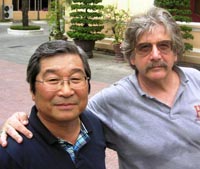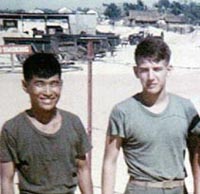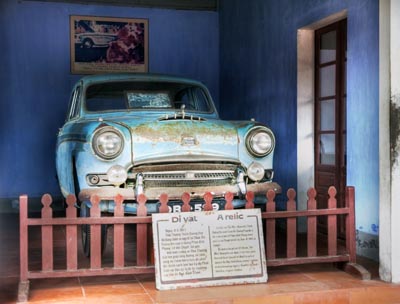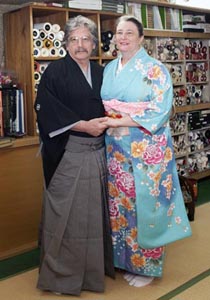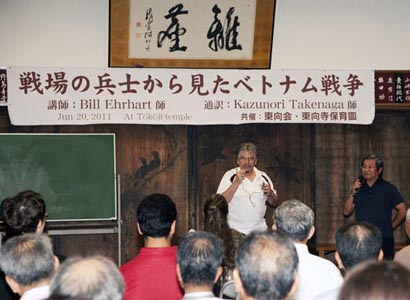 |
An Excellent AdventureBy Bill Ehrhart
Ken got the worst of it, a huge gash in his scalp and a shattered right arm. He was evacuated immediately, to Da Nang then to Hawaii. I got some small shrapnel wounds a doctor cleaned out and bandaged, slept for a few hours, then went back to the war, stone-deaf but otherwise reasonably functional. This was Hue City during the Tet Offensive. If you could walk, see, and shoot, you stayed. There were guys a lot worse off than me. It took me 32 years to find Kenny again. I didn't even know his real first name (Kazunori) or which country he lived in. Japanese-born, he was still a Japanese citizen in 1968. He'd come to the US in the midst of the Vietnam War. As a permanent alien resident he was subject to the draft, got drafted, and chose to join the Marines instead, thinking he was joining the Navy. When he got to Parris Island, he asked the drill instructors, "Where are the ships?" But that's another story. I finally tracked him down in 2000 (yet another story), and since then we've renewed our friendship as if no time at all had passed. These days, he shuttles between Japan and New York, so we get together several times a year. Ken has spent his entire adult life in the travel and tourism industry, so when he suggested a trip back to Vietnam, he didn't have to ask twice. This was not my first trip back to postwar Vietnam. I'd been back in 1985 and again in 1990. But this trip was special for two reasons. I'd be able to take my wife Anne with me this time, to share with her a place she had only, but endlessly, heard about during our thirty years of marriage. And I'd be traveling with my buddy, my comrade, who'd literally been where I'd been and knew what I knew and needed no explanations. Our journey began, however, not in Vietnam, but in Japan. Ken spent the first fifteen years of his life in the city of Yatsushiro, Kyushu, where he was raised by his maternal grandparents. Having seen where I grew up in Perkasie, Pennsylvania, Ken wanted to show us where he'd come from. We stood on the walls of the ruined feudal castle where Ken had climbed and played as a child. We saw the local jail where Ken's grandfather had once been locked up for "overspending" on election day (long before Ken was born). Though the house Ken grew up in has been replaced by a newer structure, just across the street is Kangyo-ji, the Buddhist temple where his grandparents' graves are, and where his will be some day. We spent eight days in Japan, walking across the graceful five-arch Kintai Bridge at Iwakuni (near where I had been stationed post-Vietnam in 1969), touring magnificent Kumamoto Castle, luxuriating in a private onsen (hot springs spa) at Tsuetate, making rice paper art at Shirakawa Spring, enjoying a Shinto wedding we happened upon at Aso Shrine, being decked out in traditional kimonos by a dressmaker and her two teenaged daughters (the process takes nearly an hour), dolphin-watching in Hayasaki Strait, walking amidst the awesome aftermath of the 1990 volcanic eruption of Fugendake. Among the coolest things Ken and I did together was a talk about the Vietnam War and its aftermath to the congregants of Toko-ji Zen Temple in Amakusa. Five years ago, at the request of Morinobu Okabe, 31st priest of the temple, Ken and I had translated and adapted a poem by the late Shinmin Sakamura, which Okabe-san makes available free for visiting English speakers. A good 50 people showed up for the talk, listening attentively for an hour, and then we all had a multi-course feast washed down with beer, sake, and shochu. Then it was on to Vietnam. After a night in Saigon, where the street scene can only be described as "motor-scooter madness", we flew to central Vietnam, the area between Hoi An and the 17th Parallel, where Ken and I had been stationed. We drove over the Hai Van Pass, a spectacular ride that had been charged with danger the first time we'd taken it in 1967. We climbed Marble Mountain, where throughout the war the Viet Cong had maintained a field hospital right under the noses of the Americans at Da Nang. We drove over the bridge that had once connected the rest of Hieu Nhon District to the small fishing village of Phuoc Trac, displaced now by a string of luxury beach resorts.
But the most amazing experience was finding the very building Ken and I had been in when we were wounded. During the war, it had been some bigwig's mansion, the mayor or provincial governor, a two-and-a-half story house surrounded by a yard and a wall. The bigwig had skipped town when the shooting started, so we Marines had moved in and were using it as a battalion command post. We'd spent several days trying to dislodge some North Vietnamese from the houses across the street, and were just marking time that morning, waiting for flame tanks to come and burn the block down. Ken and I were posted in a second-story bedroom. I was making a cup of C-ration coffee and Ken was cleaning his rifle when a North Vietnamese soldier put an RPG through the window. It took some work to find the building, a lot has changed in 43 years, but we found it. Completely refurbished and looking brand-spanking-new, the house is now the business offices for the four-star, six-story Duy Tan Hotel. The yard is now a tiled driveway and parking area for the hotel with a motor-scooter rental operation and an outdoor coffee shop. Only the configuration of the windows, and the location of the house itself, allowed me to be certain we had the right place. Indeed, aside from the ubiquitous cemeteries for the war dead and the occasional monument or statue, one has to look hard to find any evidence of the American War (as the Vietnamese call it). The population, doubled since 1975, is young, dynamic, and ambitious. There is new construction everywhere. Roads, bridges, in the cities, in the countryside, 20-story office buildings, single-family homes. Grass-thatched roofs have been replaced by ceramic tile. Most farmers plow their paddy fields with motorized if primitive tractors. Roads are paved, cars are commonplace, and motor-scooters and cellphones abound. The beaches up and down the entire coast of Vietnam are lined with resort hotels. VietBank and PetroVietnam are juxtaposed with Hyundai and Sheraton. The gap-toothed bridge over the River of Perfumes that the Viet Cong blew up during Tet has been rebuilt, and is lit nightly with an array of colored floodlights that makes the lighting on Philadelphia's Ben Franklin Bridge look anemic. Anne, Ken and I, together with photographer Sachiko Akama, who traveled with us, visited a fish farm and an aquarium on Hon Mieu, the Cham-built Hindu temples of Po Nagar (the oldest dating back to the 8th century), the summer palace of Emperor Tu Duc, and the tomb of emperor Khai Dinh. We went swimming in the turquoise waters of Nha Thang Bay, took a sunset cruise on the Song Cai, and ate a barbeque of fresh prawns, squid, beef, pork, tomatoes, and cucumber on Hon Mun. One evening in Hue, we went for a boat ride on the River of Perfumes, accompanied by eight singers and musicians in traditional dress performing traditional folk music. One can hardly imagine, let alone describe, the beauty, the profound tranquility, of such an experience, especially for two ex-Marines who had nearly died next to that river so many years ago. Later that night, Ken and I stood on a hotel balcony overlooking Hue. We could see the university that had been used as a refugee center, the roof of the building we'd been in, now dwarfed by the hotel built around it, the roofs of what had been the MACV compound. But the streets were crowded with noisy, jostling, energetic people. The river flowed with colorful tour boats. The bridge glowed yellow, then green, then blue. We did not speak. There was nothing to say. This is what we had come to see. A country. Not a war. Bill Ehrhart teaches at the Haverford School in suburban Philadelphia. His latest book is The Bodies Beneath the Table (Adastra Press, 2010).
|


